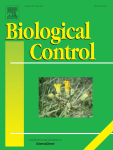View Item
- xmlui.general.dspace_homeCentros e Institutos de InvestigaciónCICVyA. Centro de Investigación en Ciencias Veterinarias y AgronómicasInstituto de Microbiología y Zoología AgrícolaArtículos científicosxmlui.ArtifactBrowser.ItemViewer.trail
- DSpace Home
- Centros e Institutos de Investigación
- CICVyA. Centro de Investigación en Ciencias Veterinarias y Agronómicas
- Instituto de Microbiología y Zoología Agrícola
- Artículos científicos
- View Item
New isolates of Trichoderma spp. as biocontrol and plant growth–promoting agents in the pathosystem Pyrenophora teres-barley in Argentina
Abstract
The fungus Pyrenophora teres, causal agent of net blotch of barley, generates important yield losses, mainly regarding grain weight and quality of malt extract for beer production. In order to find new strategies to manage this disease, we evaluated in vitro and in vivo antagonistic interactions among different native isolates of Trichoderma spp. and P. teres. The microorganisms were isolated from different barley crop areas of Buenos Aires province and
[ver mas...]
The fungus Pyrenophora teres, causal agent of net blotch of barley, generates important yield losses, mainly regarding grain weight and quality of malt extract for beer production. In order to find new strategies to manage this disease, we evaluated in vitro and in vivo antagonistic interactions among different native isolates of Trichoderma spp. and P. teres. The microorganisms were isolated from different barley crop areas of Buenos Aires province and identified according to morphological features and molecular techniques. Dual cultures were conducted to assess in vitro antagonism using direct interactions. Assays under greenhouse conditions were carried out to evaluate the efficiency of Trichoderma spp. as biocontrol and plant growth–promoting agent. In vitro, all Trichoderma spp. isolates inhibited mycelial growth of P. teres in an 18%–54% range compared to the controls. Microscopic observations of interaction zones revealed morphological alterations of P. teres such as vacuolated mycelium without typical pigmentation and coiling. In vivo, all Trichoderma isolates significantly decreased the incidence of P. teres, up to 55% on barley seedlings. Severity decreased up to 77% on stems and up to 70% on leaves. Likewise, regarding growth–promoting parameters, aerial and radicular dry weight of plants treated with Trichoderma spp. increased up to 20% and 15%, respectively. On the other hand, an increase of chlorophyll (SPAD) of up to 9% compared to the control was recorded in seedlings treated with Trichoderma.
[Cerrar]

Author
Moya, Paulina;
Barrera, Viviana Andrea;
Cipollone, Josefina;
Bedoya, Carolina;
Kohan, Lucila;
Toledo, Andrea;
Sisterna, Marina;
Fuente
Biological Control 141 : 104152 (Febrero 2020)
Date
2020-02
Editorial
Elsevier
ISSN
1090-2112
1049-9644
1049-9644
Formato
pdf
Tipo de documento
artículo
Palabras Claves
Derechos de acceso
Restringido
 Excepto donde se diga explicitamente, este item se publica bajo la siguiente descripción: Creative Commons Attribution-NonCommercial-ShareAlike 2.5 Unported (CC BY-NC-SA 2.5)
Excepto donde se diga explicitamente, este item se publica bajo la siguiente descripción: Creative Commons Attribution-NonCommercial-ShareAlike 2.5 Unported (CC BY-NC-SA 2.5)


